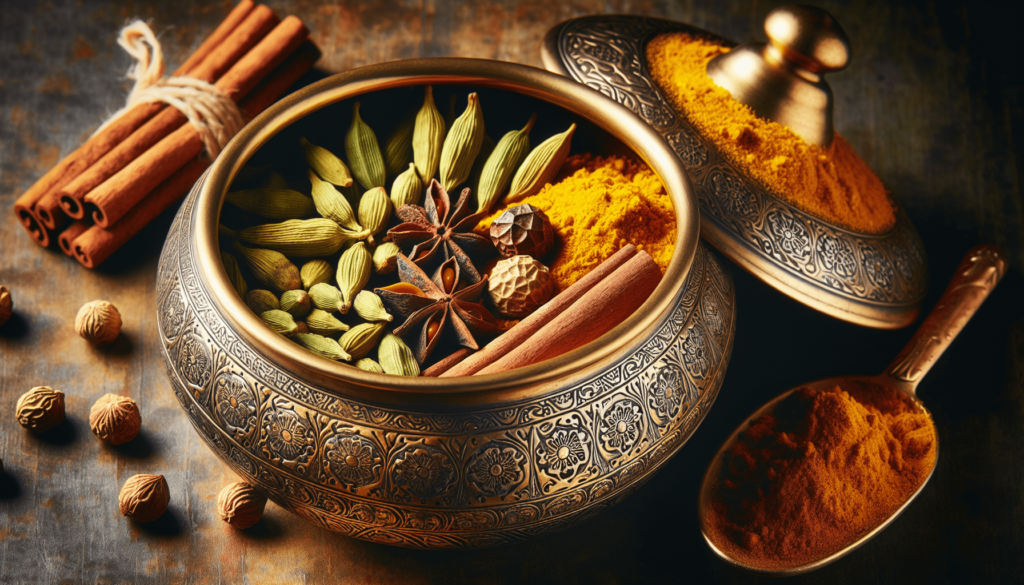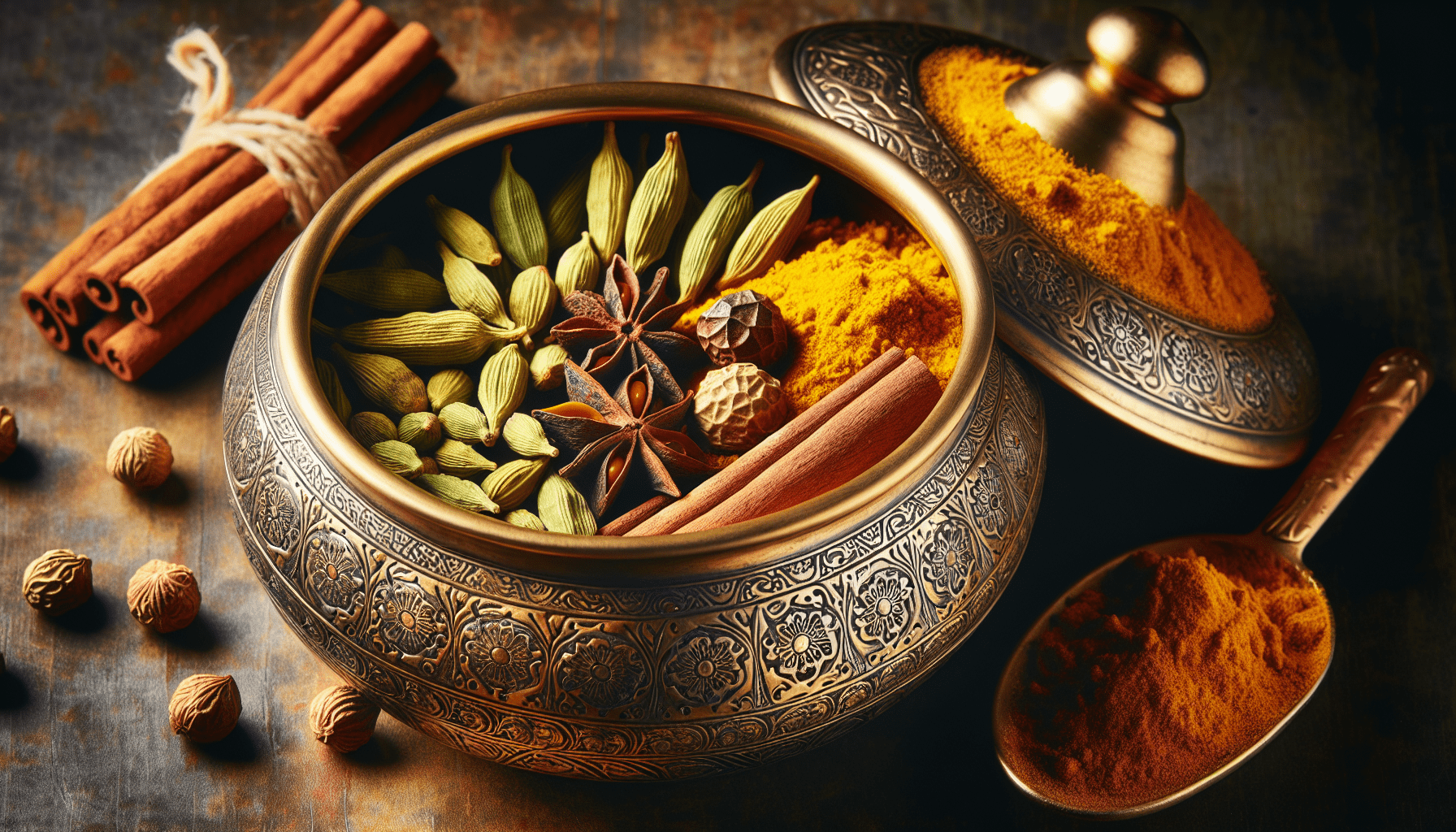Welcome to the intriguing world of Ayurvedic cooking, where ancient knowledge of food and herbs meet modern culinary techniques. In this article, you will discover the holistic approach of Ayurveda towards cooking, which focuses on balancing the body and mind through the use of herbs, spices, and specific cooking methods. Prepare to embark on a journey of nourishment, healing, and overall well-being as you delve into the fascinating realm of Ayurvedic cooking. Embrace the wisdom of this ancient tradition and learn how to create delicious and healthful meals that will nurture your body and soul. Have you ever wondered how the ancient practice of Ayurveda can influence our modern cooking habits and overall well-being? Let’s explore the fascinating world of Ayurvedic cooking together.

Understanding Ayurveda
Ayurveda is an ancient system of healing that originated in India over 5,000 years ago. It focuses on achieving a balance between mind, body, and spirit to promote overall health and wellness. The principles of Ayurveda are based on the belief that each person is made up of a unique combination of the five elements – earth, water, fire, air, and space.
Applying Ayurvedic Principles to Cooking
In Ayurvedic cooking, food is not only seen as nourishment for the body but also as a form of medicine. The type of food you eat and how it is prepared can have a significant impact on your physical, mental, and emotional well-being. Ayurvedic cooking emphasizes the use of fresh, seasonal ingredients and spices that are thought to balance the doshas, or energies, within the body.
The Three Doshas
According to Ayurveda, each person has a unique combination of the three doshas – Vata, Pitta, and Kapha. These doshas govern various functions in the body and mind. Understanding your dominant dosha can help you make informed choices about the foods you eat and how they are prepared.
Vata Dosha
Those with a dominant Vata dosha tend to be creative, energetic, and enthusiastic. However, they also have a tendency towards anxiety, dry skin, and digestive issues. To balance Vata, it is recommended to eat warm, cooked foods that are grounding and nourishing. Avoiding cold, raw foods and incorporating sweet, sour, and salty flavors can help pacify Vata.
Pitta Dosha
Individuals with a dominant Pitta dosha are often driven, intelligent, and competitive. They are prone to inflammation, irritability, and digestive problems. To balance Pitta, it is advised to consume cooling, hydrating foods that are not too spicy or overly salty. Bitter, sweet, and astringent flavors can help soothe Pitta dosha.
Kapha Dosha
Those with a dominant Kapha dosha are typically strong, stable, and compassionate. However, they can also struggle with weight gain, lethargy, and congestion. To balance Kapha, it is recommended to eat light, warming foods that are spicy and stimulating. Avoiding heavy, oily foods and incorporating pungent, bitter, and astringent flavors can help regulate Kapha dosha.
The Six Tastes
In Ayurvedic cooking, there are six tastes that are believed to influence the doshas and promote overall balance in the body. Each taste corresponds to different elements and energies.
- Sweet (Earth and Water): Promotes strength, nourishment, and satisfaction.
- Sour (Earth and Fire): Enhances digestion and stimulates appetite.
- Salty (Water and Fire): Provides minerals and electrolyte balance in the body.
- Bitter (Air and Space): Supports detoxification and cooling in the body.
- Pungent (Fire and Air): Stimulates metabolism and circulation.
- Astringent (Earth and Air): Absorbs excess moisture and promotes healing.
Balancing the Six Tastes
In Ayurvedic cooking, it is important to include all six tastes in your meals to ensure that you are receiving a well-rounded and balanced diet. By incorporating a variety of flavors and ingredients, you can support the doshas and enhance your overall well-being.
Seasonal Eating
Ayurvedic cooking emphasizes the importance of eating foods that are in season and grown locally. Seasonal eating is believed to be in harmony with nature and can help maintain the body’s internal balance.
Spring
In the spring, it is best to consume light, cleansing foods such as leafy greens, sprouts, and bitter herbs. Adding pungent spices like ginger, black pepper, and mustard can help stimulate digestion and metabolism.
Summer
During the summer months, opt for cooling foods like fresh fruits, salads, and herbs. Avoid heavy, oily foods and instead focus on hydrating options like cucumber, watermelon, and mint. Incorporating sweet and bitter flavors can help balance Pitta dosha during the hot summer season.
Fall
As the weather transitions to fall, choose warming, grounding foods like root vegetables, grains, and spices such as cinnamon, clove, and turmeric. Adding sweet, sour, and salty flavors can help pacify Vata dosha as the air becomes drier and cooler.
Winter
In the winter months, nourish your body with hearty, cooked meals like soups, stews, and grains. Opt for warming spices like cumin, coriander, and cardamom to help stimulate circulation and digestion. Including sweet and salty flavors can help balance Kapha dosha during the cold, damp winter season.

Ayurvedic Cooking Techniques
Ayurvedic cooking utilizes a variety of techniques to prepare delicious and nutritious meals that support the doshas and promote health.
Sautéing
Sautéing is a common cooking method in Ayurvedic cuisine that involves heating oil or ghee and gently frying ingredients like vegetables, spices, and grains. This technique helps to release the flavors of the ingredients and aids in digestion.
Steaming
Steaming is another popular cooking technique in Ayurveda that helps to retain the nutrients and natural flavors of the ingredients. It is a gentle and healthy way to cook vegetables, grains, and proteins.
Roasting
Roasting is a method of cooking that involves baking foods in an oven or over an open flame. Roasting enhances the natural sweetness and richness of ingredients like root vegetables, nuts, and spices.
Boiling
Boiling is a simple and effective way to cook grains, legumes, and vegetables in Ayurvedic cooking. It helps to soften the ingredients and create nourishing soups, stews, and broths.
Ayurvedic Spices and Herbs
Spices and herbs play a vital role in Ayurvedic cooking, as they are believed to balance the doshas and enhance the flavors of the dishes.
Turmeric
Turmeric is a golden spice that is known for its anti-inflammatory and antioxidant properties. It is commonly used in Ayurvedic cooking to promote digestion, support liver health, and reduce inflammation in the body.
Cumin
Cumin is a warming spice that aids in digestion, reduces bloating, and supports metabolism. It is often paired with coriander and fennel in Ayurvedic recipes to create a balanced flavor profile.
Ginger
Ginger is a versatile herb that has warming and stimulating properties. It is used in Ayurvedic cooking to improve digestion, reduce nausea, and promote circulation in the body.
Coriander
Coriander is a cooling herb that helps to detoxify the body and balance Pitta dosha. It is often ground into a powder and added to dishes for its unique flavor and health benefits.
Cinnamon
Cinnamon is a sweet and warming spice that is commonly used in Ayurvedic cooking to support digestion, regulate blood sugar levels, and reduce inflammation in the body.
Cardamom
Cardamom is a fragrant spice that aids in digestion, freshens breath, and reduces bloating. It is often added to teas, desserts, and savory dishes in Ayurvedic cuisine.
Ayurvedic Meal Planning
When following an Ayurvedic diet, it is important to plan your meals mindfully to ensure that you are nourishing your body in accordance with your dosha.
Breakfast
For breakfast, choose warm, cooked foods like oatmeal, spiced porridge, or savory vegetable frittatas. Include ingredients that are grounding, nourishing, and easy to digest to start your day on the right foot.
Lunch
Lunch is considered the main meal of the day in Ayurvedic cooking. Opt for a balanced plate with grains, vegetables, proteins, and healthy fats. Add warm spices and herbs to aid digestion and support the doshas.
Dinner
Dinner should be light and easily digestible in Ayurvedic cooking. Choose soups, stews, or stir-fries with a variety of flavors and textures. Avoid heavy or stimulating foods close to bedtime to promote restful sleep.
Snacks
When snacking, opt for small, nourishing options like fresh fruit, nuts, seeds, or herbal teas. Incorporate the six tastes into your snacks to satisfy cravings and support balance in the body.
Ayurvedic Food Combining
Ayurvedic food combining is a practice that involves pairing foods together based on their qualities and effects on the doshas. By following food combining principles, you can optimize digestion and absorption of nutrients.
Eating Fruit
In Ayurvedic cooking, it is recommended to eat fruit on its own and not combined with other foods. This allows for easier digestion and absorption of the natural sugars and vitamins in the fruit.
Protein and Carbohydrates
When combining protein and carbohydrates in a meal, opt for lean proteins like poultry or legumes paired with whole grains like quinoa or rice. This combination provides a balanced source of energy and sustenance.
Avoiding Dairy and Tropical Fruits
In Ayurveda, it is advised to avoid combining dairy products with tropical fruits like banana, mango, or pineapple. This combination can lead to digestive issues and create imbalances in the body.
Eating Cooked and Raw Foods
In Ayurvedic cooking, it is best to eat raw foods like salads and fresh vegetables before cooked foods like grains or proteins. This helps to stimulate digestion and support the assimilation of nutrients.
Ayurvedic Lifestyle Practices
Ayurveda extends beyond just dietary choices and encompasses various lifestyle practices that promote health and well-being.
Mindful Eating
Practice mindful eating by savoring each bite, chewing your food thoroughly, and eating in a calm and peaceful environment. This allows for better digestion and appreciation of the nourishment you are receiving.
Daily Routine
Establishing a daily routine that aligns with your dosha can help create balance and stability in your mind and body. This includes waking up and going to bed at consistent times, eating meals at regular intervals, and engaging in self-care practices.
Yoga and Meditation
Yoga and meditation are integral practices in Ayurveda that help to improve flexibility, calm the mind, and reduce stress. Incorporating gentle movement and mindfulness into your daily routine can support the doshas and promote overall wellness.
Self-Care Rituals
Engage in self-care rituals that nourish your body, mind, and spirit. This can include practices like dry brushing, oil massage, herbal baths, and aroma therapy. Find activities that bring you joy and relaxation to support your overall well-being.
Conclusion
Incorporating Ayurvedic cooking principles into your daily life can have a profound impact on your health and well-being. By understanding your dosha, balancing the six tastes, and following food combining practices, you can create meals that support your unique constitution and promote harmony within your body. Embrace the ancient wisdom of Ayurveda and discover the transformative power of holistic cooking.

